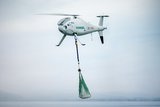MQ-8C Fire Scout prepares for ship-board testing
The MQ-8C Fire Scout unmanned aerial vehicle (UAV) is set to undergo testing to ensure it can safely operate within intense electromagnetic environments in preparation for ship-board flights later in 2014 with the US Navy.
The Fire Scout uses specially designed Faraday cages to protect sensitive equipment on the UAV from signal interference during flight. The cage ensures that strong electric fields and electromagnetic interference do not compromise the aircraft’s electric components.
Capt Patrick Smith, Fire Scout program manager, Naval Air Systems Command, said: ‘All navy aircraft must go through electromagnetic interference testing to ensure they can operate safely in the ship environment. We're confident that the design of the Faraday cages and other engineering work done on the MQ-8C Fire Scout will pass these tests.’
Summit Aviation was selected in 2012 to manufacture the protective enclosures, which are installed during final assembly of the Fire Scout system.
The MQ-8C is based on a larger helicopter airframe and can fly almost twice as long and carry three times more intelligence-gathering sensor payloads than the MQ-8B variant.
The US Navy placed an order with Northrop Grumman for five additional MQ-8C Fire Scout UAVs earlier this month, bringing the total number of Fire Scout aircraft under contract with the US Navy to 19.
Related Equipment in Defence Insight
More from Uncrewed Vehicles
-
Jammer resistant drone designs spark search for countermeasures
The Russia-Ukraine conflict has driven another stage of evolution for drones and the counter measures to defend against them.
-
![L3Harris launches Amorphous software for control of uncrewed platforms]()
L3Harris launches Amorphous software for control of uncrewed platforms
The new Amorphous software is a universal controller that would allow a single operator to control a swarm of “thousands” of uncrewed systems, from drones to underwater platforms.
-
ideaForge unveils new UAVs at Aero India 2025
India UAV supplier ideaForge has launched the Netra 5 and Switch V2 drones at Aero India 2025, boasting of enhanced endurance, AI-driven autonomy and improved operational capabilities.
-
![Shaping the future of defence: What 2025 holds for the global drone market]()
Shaping the future of defence: What 2025 holds for the global drone market
The UAV market is experiencing unprecedented growth, with innovations in technology and battlefield applications driving demand across military sectors. From the battlefields of Ukraine to NATO exercises and beyond, drones are transforming how wars are fought and supported.
-
![Maris-Tech confirms customers signing up for Jupiter Drones codec and AI-powered system]()
Maris-Tech confirms customers signing up for Jupiter Drones codec and AI-powered system
Launched at AUSA in October, the company’s multi-stream video codec is attempting to bring a new lease of life to drone technology through its AI accelerator.
-
![AUSA 2024: Quantum-Systems targets big 2025 with UAS developments]()
AUSA 2024: Quantum-Systems targets big 2025 with UAS developments
Quantum-Systems has been upgrading its UAS family, with new versions of the Vector, Reliant and Twister drones set for release throughout 2025.
























